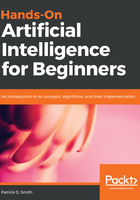
Summary
Machine learning, and by extension, deep learning, relies on the building blocks of linear algebra and statistics at its core. Vectors, matrices, and tensors provide the means by which we represent input data and parameters in machine learning algorithms, and the computations between these are the core operations of these algorithms. Likewise, distributions and probabilities help us model data and events in machine learning.
We also covered two classes of algorithms that will inform how we think about ANNs in further chapters: supervised learning methods and unsupervised learning methods. With supervised learning, we provide the algorithm with a set of features and labels, and it learns how to appropriately map certain feature combinations to labels. In unsupervised learning, the algorithm isn't provided with any labels at all, and it must infer relationships and information from the data. Lastly, we learned about basic ways to tune our models to help us improve their accuracy.
Now that we have a core understanding of some of the underlying mechanisms that allow us to create extraordinary AI systems, let's learn about the platforms and tools that we will create these systems with.